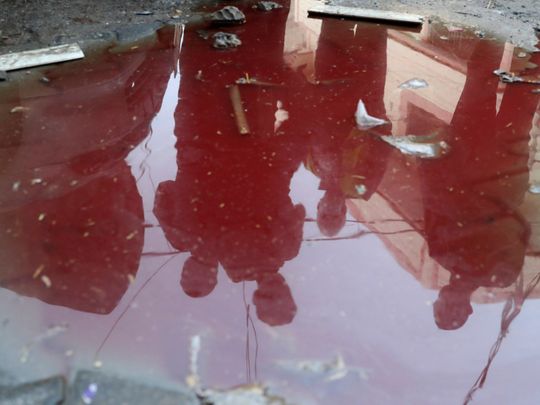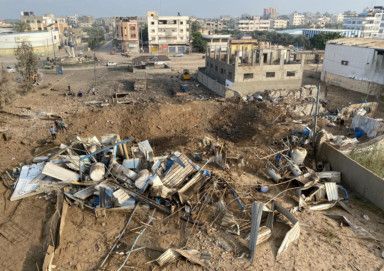
Jerusalem: Weeks of simmering tensions in Jerusalem between Palestinian protesters, the police and right-wing Israelis suddenly veered into military conflict Monday, as a local skirmish in the decades-long battle for control of the city escalated into rocket fire and air strikes in Gaza, which left 24 dead, including nine children.
After a raid by Israeli police on the Al Aqsa Mosque in Jerusalem left 700 Palestinians and a score of police officers wounded, Hamas in Gaza responded by firing a barrage of rockets at Jerusalem, drawing Israeli air strikes in return.
The catalyst for the escalation was the conflict over recent Israeli efforts to remove Palestinians from strategic parts of the city. The issue became a rallying cry for Palestinians, who saw the moves as ethnic cleansing and illegal, and right-wing Israeli Jews, who said they were fighting for their property as landowners while also attempting to ensure Jewish control over East Jerusalem.
The dispute, focused on a single Jerusalem neighbourhood, has exploded into a major flare-up in the Israeli-Palestinian conflict.
By the end of the day Monday, Hamas, the Islamist militant group that controls Gaza, had fired rockets at Jerusalem for the first time in seven years. Israeli air strikes followed, killing 24 people. And the region was bracing for a cycle of reprisal attacks.
Jerusalem clashes
For weeks, Palestinians had been protesting the planned eviction of Palestinian families from the Sheikh Jarrah neighbourhood of East Jerusalem, leading to clashes with Israeli police and far-right-wing activists. There were also clashes between Palestinian protesters and police elsewhere in the city, as well as a spate of assaults by Jewish and Arab street mobs, during the holy Muslim month of Ramadan, when tensions often run high.
The violence Monday began after police entered the mosque compound around 8am and fired rubber-tipped bullets and stun grenades at stone-throwing Palestinians.
The Israeli government said police had been responding after the Palestinians started throwing stones at them. The Palestinians had stockpiled stones at the site in expectation of a standoff with police and Jewish far-right groups.
Palestinian witnesses said the fighting began after police entered the mosque compound and began firing.

By the afternoon, more than 330 Palestinians had been injured, with at least 250 hospitalised, according to the Palestinian Red Crescent. One person was hit in the head by a bullet and was in critical condition, the medical aid group said, with at least two more in serious or critical condition.
At least 21 police officers were injured, according to police.
Hamas had been threatening for weeks to respond with force to what it described as Israeli provocations in Jerusalem. “Tampering with Jerusalem will burn the heads of the occupiers,” Saleh Al Arouri, a senior Hamas official, said Sunday night.
On Monday, angered by the raid on the Al Aqsa Mosque, Hamas and its allies in Gaza sought to make good on that promise.
Hamas fired at least 150 rockets across southern and central Israel, the Israeli army said, with at least one landing in a village in the hills west of Jerusalem, causing damage to houses but no casualties.
The volley of half a dozen rockets that reached the Jerusalem area were the first to be fired toward the city since 2014, an army spokesperson said.
Israel returned fire with air strikes.
“Israel will respond with great force,” Prime Minister Benjamin Netanyahu warned in a statement. “We will not tolerate attacks on our territory, on our capital, on our citizens and on our soldiers. Whoever attacks us will pay a heavy price.”
The Israeli military said in a statement that an Israeli air strike had killed eight Hamas operatives and struck two military sites and a tunnel used by militants.
Separately, the Islamic Jihad group fired an anti-tank missile from the Gaza perimeter toward an Israeli vehicle, wounding the driver.
An unusually high number of Palestinian citizens of Israel protested in solidarity with Gaza after the air strikes, with many photographed waving Palestinian flags.
The Palestinian demonstrations over the planned expulsions in Sheikh Jarrah came after years of frustration over Israeli restrictions on building permits in East Jerusalem, which have forced Palestinian residents to leave the city or build illegal housing and risk demolition. There have also been recent clashes over restrictions on Palestinian access to a popular plaza at the centre of Palestinian communal life.
The unrest was long predicted to come to a boil Monday, when far-right Israelis were scheduled to march through the Muslim Quarter of the Old City.
The march on Jerusalem Day, an annual event to mark the capture of East Jerusalem during the Arab-Israeli war in 1967, is seen by Palestinians as a provocation. Palestinians claim East Jerusalem as the capital of a future state. Israel annexed it after 1967, a claim most of the world does not recognise.
Despite international calls to tamp down the crisis, the Israeli government did little to de-escalate the tensions until Sunday night, when the Israeli Supreme Court delayed a decision on the eviction of the Sheikh Jarrah families. The ruling had been expected Monday.
Israeli police decided Monday to block Jews from entering the Al Aqsa compound, known to Jews as the Temple Mount and to Muslims as the Noble Sanctuary and holy to both religions. And minutes before the Jerusalem Day march was to begin Monday afternoon, the government rerouted it on a less contentious path.
Those measures came too late to contain the spiralling violence.








